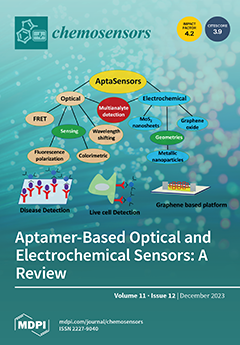This work presents the electrochemical determination of cholecalciferol (Vitamin D
3) in water-organic mixtures using a glassy carbon electrode (GCE) and commercial screen-printed carbon electrodes (SPCEs). The electrocatalytic behavior of Vitamin D
3 on the surface of the working electrode produced a
[...] Read more.
This work presents the electrochemical determination of cholecalciferol (Vitamin D
3) in water-organic mixtures using a glassy carbon electrode (GCE) and commercial screen-printed carbon electrodes (SPCEs). The electrocatalytic behavior of Vitamin D
3 on the surface of the working electrode produced a well-defined oxidation peak at +0.95 V (vs. Ag|AgCl, 3.0 mol L
−1) and +0.7 V (vs. Ag-SPCE pseudo-reference electrode) for the GCE and SPCE, respectively, in 0.1 M LiClO
4 prepared in 50% ethanol. The nature of the organic solvent needed for the solubilization of Vitamin D
3 was evaluated, together with the concentration of the supporting electrolyte, the ratio of the water-organic mixture, the voltametric parameters for the cyclic voltammetry (CV), and square-wave voltammetry (SWV) analyses. Under the optimized conditions, a linear correlation between the anodic peak current and the concentration of Vitamin D
3 was obtained over the range of 0.47 to 123 µmol L
−1 and 59.4 to 1651 µmol L
−1 for the GCE and SPCE, respectively. The determined limits of detection (LOD) were 0.17 (GCE) and 19.4 µmol L
−1 (SPCE). The methodology was successfully applied to commercial supplement tablets of Vitamin D
3. Additionally, this work shows the possibility of using non-modified GCE and SPCE for routine analysis of Vitamin D
3.
Full article





